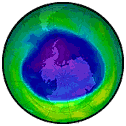




Heal the Ozone Layer The thin Ozone layer is made of Oxygen3, it now has major holes in it. The holes are as large as countries. The holes let the harmful UV rays to hit the earth. More sun burns and more skin cancer, let alone knowing what it is doing to the plants and animals. They used to blame the ozone braking up on perfluorocarbons (spray paint, freon, and other products) but now they finally admit it is the SMOG that is causing all the trouble. The Oil Corp.s spend millions on disinformation people and lobbists who asy no SMOG is good for the planet. We will all die eventually by greenhouse gasses and global warming as the ice caps are melting at an alarming rate.. We need to get rid of SMOG and need more oxygen. Burning the rain forest does not help, paving paradise with parking lots, and development, cement and asphalt not planting green plants, lawns, gardens are needed more. We need a Green Revolution. Hydrogen is the most abundant element in the universe and it has the highest energy content per unit of weight of any known fuel. Hydrogen when burned produces only heat, water and oxides of nitrogen, thus emissions are nearly zero when compared to fossil fuels. Herman's patented hydrogen technologies will reverse the greenhouse effect and bring an end to global warming, because there is no carbon dioxide produced in the combustion process. Finally the problem of cleaner burning cars has been answered. This is just one of the many advantages to using hydrogen.
Hydrogen Will Be Our Free Energy Savior. Just like Christ can Save Our Souls, Re-written by Bucko Bonzai Hydrogen-powered cars and trucks that use fuel cells to drive electric motors instead of internal-combustion engines could potentially eliminate tail-pipe pollution and dependence on foreign oil. But hydrogen is not an energy source. It is only an energy carrier that must be produced from a primary energy source, such as natural gas, coal, nuclear fuel, wind or solar radiation. There are two main methods for making hydrogen. The dominant commercial method uses natural gas and steam to produce ultimately hydrogen and carbon dioxide. In this process, called steam reforming, less than 80 percent of the input energy is left in the hydrogen; then another 15 percent or more is lost converting the hydrogen to liquid or compressed gas. Thus, at most only two-thirds of the original energy ends up as useful hydrogen. Moreover, natural gas is an expensive non-renewable fossil fuel that is in short supply. Furthermore, natural gas has many other important uses, such as heating our homes and serving as a feedstock for many chemicals. Why get hydrogen from burning hydro carbons, why not simply get hydrogen out of water through electrolysis. Read below. The other main way of making hydrogen is by electrolysis. This process is straightforward and the most rewarding. THe most energy effect process, but it won't require any fossil fuel, because the big oil wigs don't want to lose, lose big time. Bye, Bye, is more like it. It uses an electrolyze, in which a current is passed through water, to split the water into hydrogen and oxygen. Just like Tesla's inventions were hidden from us, so is the 100% water car, OBH On board An electrolyzer is essentially a fuel cell operating in reverse. But the electricity must first be produced from a primary energy source. At the very best, only half as much electricity can be obtained from the hydrogen as is consumed to make it. If electricity from the grid were used to produce the hydrogen, over 50 percent of the electric energy would come from coal-fired power plants, which are the most polluting source. If hydrogen produced by electrolysis were used as fuel, the president's statement should be amended from a "pollution-free car" to a "pollute elsewhere car." Environmentalists recommend using solar energy or wind to generate electricity for a "renewable hydrogen economy." We have been staunch supporters of renewable energy for half a century and recently some renewable options have achieved economic competitiveness in favorable locations. But the renewable hydrogen path to electricity would more than double the cost of electricity, and probably would set back deployment of renewable electric power for decades. Wind, solar and biomass should be used for heat and power generation, not for making hydrogen. The nuclear industry argues that reactors are the preferred option to make hydrogen for fuel cells, because they do not generate greenhouse gases. If the public is willing to accept the risks associated with transport and storage of nuclear waste, nuclear power is an available option. But, using nuclear-generated electricity to make hydrogen, from which to make electricity, is a waste of energy and money. Petroleum engineers predict that worldwide petroleum production will peak in 10 to 30 years. Once production begins to decrease, it will be necessary to supplement oil with some other fuel or to reduce consumption by conservation measures, such as increased mileage of the vehicle fleet and using mass transport. Both of these changes will take time, and we must begin to plan now. Fortunately, there are several technologies to reduce petroleum consumption. The most obvious is to increase the mileage of the auto and pickup fleet. This can be achieved by building smaller cars and running your vehicles totally on water, such as the Egas Power Monger. Hybrids use a small gasoline or diesel engine that always runs at maximum efficiency and charges on-board batteries when it produces excess power; when needed, the hybrid draws energy from the batteries to run an electric-drive motor. Battery technology has improved enormously in the past decade, and state-of-the-art batteries in hybrids increase mileage. But even greater reductions in fuel consumption and pollution can be achieved with "plug-in," electric-gasoline or diesel hybrids, by charging their batteries overnight when excess electrical capacity is available. Demonstration-model plug-in hybrids are on the road and need no new technology for their large-scale deployment. It has been estimated that plug-in hybrids could approach and perhaps even exceed 100 miles per gallon of fuel used. It is also possible to replace petroleum-based fuels with liquid fuels made from coal or biomass, further reducing our dependence on imported petroleum. There are no huge technical obstacles to making hydrogen and using it as a fuel. But a hydrogen economy would be more expensive and use more primary energy than other options. Moreover, it would require many hundreds of billions of dollars to build a storage and transport infrastructure. So lets for forget about idea and go with OBE, On Board Electrolysis with your own garden hose to fill up your tank. We should not accept President Bush's statement that hydrogen will replace oil without examining other options that are more economical and for which the technology and infrastructure already exist. Like a FREE water powered car you dumbshit. © 2005 Daily Idiots
|






